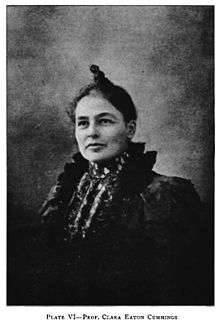Clara Eaton Cummings
Clara Eaton Cummings (13 July 1855 – 28 December 1906) was an American cryptogamic botanist and Hunnewell Professor of Cryptogamic Botany at Wellesley College in Massachusetts.
Clara Eaton Cummings | |
|---|---|
 | |
| Born | 13 July 1855 |
| Died | 28 December 1906 (aged 51) |
| Nationality | American |
| Scientific career | |
| Fields | Botany |
| Institutions | Wellesley College |
Life and education
Cummings was born in Plymouth, New Hampshire, on July 13, 1855 to Noah Conner and Elmira George Cummings.[1] In 1876, she enrolled at the women's liberal arts college Wellesley, only one year after the opening of the institution.
Career
Cummings primarily studied cryptogamous (spore-reproducing) plants such as mosses and lichens. She characterized hundreds of lichen specimens but was "very conservative" on declaring new species.[2] Much of her work appeared in the books of other botanists,[2] although she did publish a catalog of liverworts and mosses of North America in 1885.[3]
She became a curator at the botanical museum at Wellesley from 1878–79 and was hired at Wellesley as an associate professor of botany for the 1879 school year.[1][4] In 1886 and 1887 she studied under Dr. Arnold Dodel at the University of Ziirich where she did private work and prepared charts for a Cryptogamic Botany illustration. While in Europe, she traveled to various botanical gardens to study some of the great botanists.[5] After returning from Zurich, Cummings became an associate professor of cryptogamic botany at Wellesey.[1]
In 1904, she published a catalog of 217 species of Alaskan lichens collected during the Harriman Expedition which included 76 species new to Alaska and at least two species new to science.[6]
In February and March 1905, Cummings took a trip to Jamaica where she collected lichens. After her death, her collection was sent to the New York Botanical Garden.[7]
Cummings was an associate editor of Plant World and named a fellow of the American Association of the Society of Plant Morphology and Physiology in 1904.[8] She was a member of the American Association for the Advancement of Science, and the Boston Society of Natural History.[4]
Partial bibliography
Notes
- The Granite Monthly: A New Hampshire Magazine. Granite Monthly Co. 1907-01-01.
- Palmieri, Patricia Ann. In Adamless Eden: The Community of Women Faculty at Wellesley. p. 117.
- Cummings, Clara (1885). Catalogue of Musci and Hepaticae of North America, North of Mexico. Howard and Stiles.
- Kiser, Helene Barker (1999). "Clara Eaton Cummings". In Pamela Proffitt (ed.). Notable Women Scientists. Gale Group. pp. 119–120. ISBN 978-0-7876-3900-6.
- Wellesley news : Free Download & Streaming. Internet Archive. Wellesley, Mass : Wellesley College. Retrieved 2015-11-21.
- Fink, Bruce (3 May 1907). "A Memoir of Clara E. Cummings". The Bryologist. 10 (3): 37–41. doi:10.1639/0007-2745(1907)10[37:amocec]2.0.co;2. JSTOR 3238923.
- Riddle, Lincoln W. (1912-05-01). "An Enumeration of Lichens Collected by Clara Eaton Cummings in Jamaica: I". Mycologia. 4 (3): 125–140. doi:10.2307/3753489. JSTOR 3753489.
- "Cummings, Clara Eaton (1855-1906)". Cite journal requires
|journal=(help) - IPNI. Cumm.
- Cummings, Clara Eaton. The lichens of Alaska. Washington. hdl:2027/mdp.39015052517748.
External links
- Works by Clara Eaton Cummings at LibriVox (public domain audiobooks)
